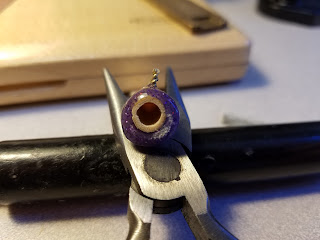Select Tube Cane:
- I am currently using Medir/Gonzalez from Midwest Music Imports
- Watch out for dark streaks. If you can scrape the dark streaks with your finger, move along
- Choose the straightest pieces or the pieces that are straight long enough to cut into cane
Gouging/Profiling/Shaping:
- Split the cane bisecting any areas that are flat
- Roll the piece to find where it settles
- Mark and split through those sections
- Pre-gouge
- Gouge, be sure to not over-gouge
- You need enough cane to achieve an effective profile
- Profile in a manner that will allow an even taper from collar to tip
- Do not treat your profiler like a tip finishing machine
- It is better to hand profile heavier blades after using a profiling machine
- Leave enough cane to work with during the finishing process
- Shaping is highly subjective
- I am currently using/enjoying a Fox 1 straight shaper
Scoring
- I start scoring 1 mm below the collar and breaking through the cane 3 mm from the butt
Making blanks:
- Using the side of a flat file, create a depression in which the top wire can sit without sliding down over time (pictured above)
- mark a 1/2 inch bevel (pictured above)
Internal Bevel: Rian Craypo
Place the Wires:
- Place the top wire, 24 gauge, as close to the collar as possible
- Place the 2nd wire, 22 gauge, 9 mm from the collar
- Place the 3rd (bottom) wire, 21 gauge, 3.5 mm from the butt
Wrap/hot-glue/shrink-wrap to your liking:
- I leave access to the 3rd (bottom) wire just in case I want to make an adjustment i.e. to fit with a different bocal
Ream:
- I use Rieger reamers
- Course reamer first, followed by fine/diamond reamer
- Finish with a round file as needed
Ream and tip opening on Rieger shape:
Tip opening on Fox shape:
Finish the blank:





















No comments:
Post a Comment